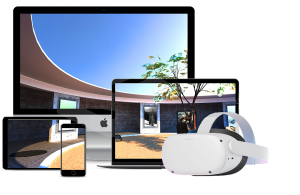You can monitor, diagnose, and investigate operational data with the visual context of 3D assets, powered by Azure Digital Twins data, without the need for 3D expertise using Azure Digital Twins 3D Scenes Studio and the Hyperspace Metaverse Platform. Your own 3D mesh can be used in both platforms, supported formats are GLB and GLTF.
See an interactive example here.
Digital Twins can be viewed as life size in the Hyperspace Metaverse Platform on any device, from mobile phones to VR/AR headsets.
Visit an example here.
Azure Digital Twins 3D Scenes Studio is described as a low-code product, whereas Hyperspace Metaverse Platform is a no-code environment.
Controlling animations of 3d models based on digital twin data to reflect the state of an object (eg. a wind turbine has stopped spinning) is supported by Hyperspace Metaverse Platform but not in Microsoft Azure Digital Twins 3D Scenes Studio at this time.
You will need an Azure subscription and some technical knowledge to configure Azure Digital Twins. Follow this link to access 3D Scenes Studio.
The viewer component of Azure Digital Twins 3D Scenes Studio can be embedded into the Hyperspace Metaverse Platform (see the guide below).
Using elements (a self-defined parts of a 3D mesh) they can be linked to data on one or more underlying digital twins.
You can connect elements to a twin in your Azure Digital Twins instance so that the element can represent your twin and its data within the 3D visualization.
Using behaviors you can leverage data on the elements in your digital twin to drive visualizations. You can configure statuses and alerts, add widgets, and display different layers. Statuses are data-driven overlays for elements that indicate the health or status of the element. Status can be represented automatically by setting the color of elements. Customized alerts allow for conditional notifications to help see when an element requires. Widgets are 2D info popups that provide additional context and data, this can include gauges, url links and digital twin property values.
You can also create scene layers to enable custom views of behavior(s).
Embed into Hyperspace Metaverse Platform
- View the Digital Twin
- Click the Share icon
- Click the Copy link button
A link will be copied to your clipboard
Eg.
https://explorer.digitaltwins.azure.net/3DScenes/demo?sceneId=02fe3198727a77eff7b109661a581cbc&selectedLayerIds=5f9f3dcead0aeb9ee69e19567b1b4b77%2Cbf42b52b638f32603ac530e0b8918159%2C7333d0b3718f5cd01e73902565219314&mode=Viewer&adtUrl=https%3A%2F%2Fdemoadtenvironment&storageUrl=https%3A%2F%2Fdemocontainer |
Link the Digital Twin to a 3D item in the space. In this case we have a model of the 3D space station and we edit the onclick action.
In the action editor add a Custom action called displayMediaboard and add a parameter url with the value pasted from your clipboard.
Clicking on the space station model launches the Digital Twin in an interactive overlay.
Learn more about configuring Azure Digital Twins here

